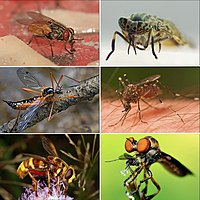
Photo from wikipedia
Aedes mosquitoes belong to a subgenus of Stegomyia (Diptera: Culicidae), which are dengue and chigunkunya vectors, including Aedes aegypti, Ae. albopictus, and Ae. scutellaris, and have a worldwide distribution in… Click to show full abstract
Aedes mosquitoes belong to a subgenus of Stegomyia (Diptera: Culicidae), which are dengue and chigunkunya vectors, including Aedes aegypti, Ae. albopictus, and Ae. scutellaris, and have a worldwide distribution in tropical and subtropical regions. Species identification of mosquitoes is challenging yet necessary to select appropriate control methods for each species. In this study, we have analyzed the different wing components for identification to find the optimal outline for Aedes mosquito analysis by an outline-based GM approach. Two internal and external outlines of the wing were considered for Aedes species identification in this study. A total of 90 Aedes wings were analysed, divided into 30 wings per species (Ae. aegypti, Ae. albopictus, and Ae. scutellaris). The results showed that the mean size of Ae. albopictus had the largest wings, followed by Ae. Aegypti, and Ae. scutellaris, respectively, in all the internal and external outlines. While, the shape analysis in the three outlines were expressed by the factor map, the statistical difference and cross-validated classification scores indicated the ability of the outline-based GM approach to distinguish species of Aedes mosquitoes. The external outline has a relatively good range of cross-validated classification scores compared to the other internal outlines. The results of this research reveal the suitability of this external outline to identify species of Aedes vectors in Thailand.
Journal Title: Journal of Entomological and Acarological Research
Year Published: 2019
Link to full text (if available)
Share on Social Media: Sign Up to like & get
recommendations!